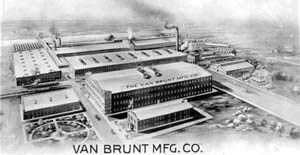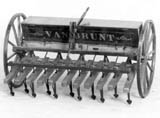Van Brunt Manufacturing Company
Although it is believed that the Assyrians used a crude sort of grain planting drill more than 24 centuries ago, and that an Italian named Carillina invented a seeding machine a few years before the Mayflower set sail for North America, it took a turnip, wild birds, and a couple of inventive brothers to produce the world's first successful seed broadcasting machine. The time was 1860. The wild birds were passenger pigeons, numbered in millions then, but extinct since 1914. The brothers were Daniel C. and George W. Van Brunt, and the turnip was used by George Van Brunt to carve the first model of the force-feed device for the Van Brunt seeder.
History holds more information about Daniel Van Brunt than about his brother. Born in the east, owner of a wagon and carriage shop in Mansville, N. Y., while still in his 20's, Daniel Van Brunt sold his business in 1846 (the year before John Deere moved to Moline) and settled near Mayville, in Dodge county, Wisconsin. There he opened a wagon and blacksmith shop, and promptly built the first farm wagon ever made in that area. Grain was sown by hand in those days, a process laborious and slow at best, and well-nigh futile when hordes of wild pigeons followed the sowers, as they did in 1859, eating every seed almost before it touched the ground.
 In 1860 they built seven of the seeders, the next year 60-but they might never have sold a one if it hadn't been for the wild pigeons. Even so, many farmers had little confidence in the "new-fangled" machines, and only bought them on personal warranty from the brothers that they would raise as much grain with the seeders as by the old method of broadcasting by hand and covering with a drag.
In 1860 they built seven of the seeders, the next year 60-but they might never have sold a one if it hadn't been for the wild pigeons. Even so, many farmers had little confidence in the "new-fangled" machines, and only bought them on personal warranty from the brothers that they would raise as much grain with the seeders as by the old method of broadcasting by hand and covering with a drag.
Early sales resistance grudgingly weakened as the seeders proved their worth, and by 1866 total sales had exceeded 4,000. About that time George Van Brunt left the partnership, although Daniel took an active and aggressive part in the company's operations until his death at 83, in 1901.
Meanwhile Daniel's eldest son, Willard, was growing up. He served an apprenticeship in his father's factory, and at the age of 21 was made shop superintendent. It was a responsible job with a secure future, but the Van Brunt pioneer spirit hadn't ended with Daniel-and three years later Willard left his father's factory to start one of his own. He called his seeder the "New Van Brunt", and afterward the "Monitor", and for twenty years he and his father were in direct, although friendly, competition. In 1891 he sold his interests and rejoined his father's company, becoming its president when Daniel Van Brunt died. Not only did the company continue to prosper under his leadership, but he invented and developed many devices which more firmly established it as the world's leading grain drill factory, both as regards quality and volume.
 As more farmers learned to say "Van Brunt" when they spoke of grain drill quality, so did it become more inevitable that the Deere & Co. merger of 1911 should include the Van Brunt Manufacturing Co. That is what happened, although Willard Van Brunt continued as president and acting head of the subsidiary company until his retirement in 1917.
As more farmers learned to say "Van Brunt" when they spoke of grain drill quality, so did it become more inevitable that the Deere & Co. merger of 1911 should include the Van Brunt Manufacturing Co. That is what happened, although Willard Van Brunt continued as president and acting head of the subsidiary company until his retirement in 1917.
Located in Horicon, Wis., where Daniel and George Van Brunt moved in the second year of their partnership, the Van Brunt Manufacturing Co. built grain drills, combination fertilizer-grain drills, lime and fertilizer distributors, calcium chloride distributors, field and orchard cultivators, and various drill attachments.
Copyright© 2003 Deere & Company Archives
